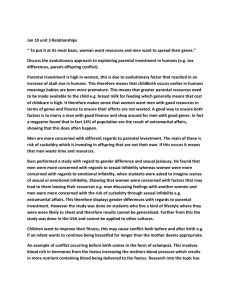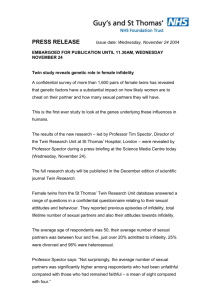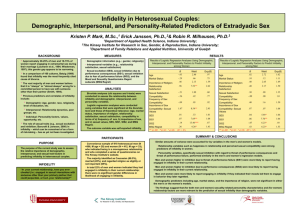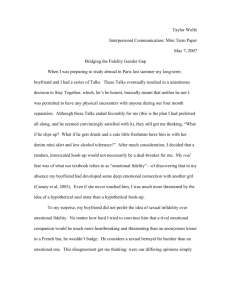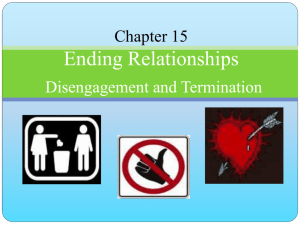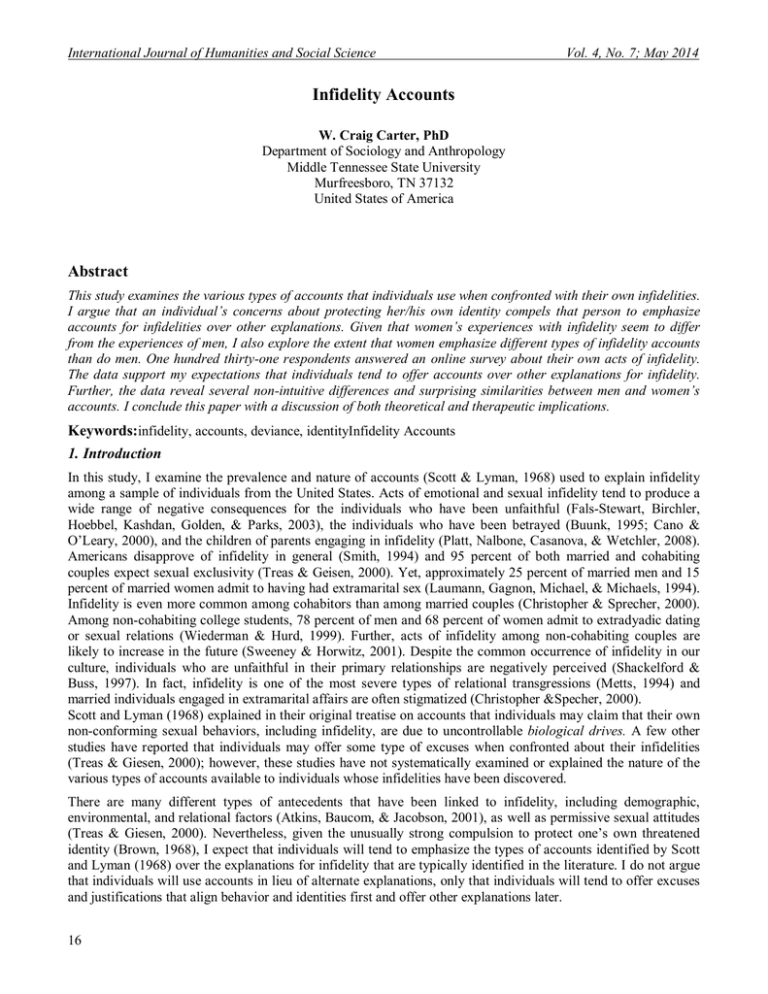
International Journal of Humanities and Social Science
Vol. 4, No. 7; May 2014
Infidelity Accounts
W. Craig Carter, PhD
Department of Sociology and Anthropology
Middle Tennessee State University
Murfreesboro, TN 37132
United States of America
Abstract
This study examines the various types of accounts that individuals use when confronted with their own infidelities.
I argue that an individual’s concerns about protecting her/his own identity compels that person to emphasize
accounts for infidelities over other explanations. Given that women’s experiences with infidelity seem to differ
from the experiences of men, I also explore the extent that women emphasize different types of infidelity accounts
than do men. One hundred thirty-one respondents answered an online survey about their own acts of infidelity.
The data support my expectations that individuals tend to offer accounts over other explanations for infidelity.
Further, the data reveal several non-intuitive differences and surprising similarities between men and women’s
accounts. I conclude this paper with a discussion of both theoretical and therapeutic implications.
Keywords:infidelity, accounts, deviance, identityInfidelity Accounts
1. Introduction
In this study, I examine the prevalence and nature of accounts (Scott & Lyman, 1968) used to explain infidelity
among a sample of individuals from the United States. Acts of emotional and sexual infidelity tend to produce a
wide range of negative consequences for the individuals who have been unfaithful (Fals-Stewart, Birchler,
Hoebbel, Kashdan, Golden, & Parks, 2003), the individuals who have been betrayed (Buunk, 1995; Cano &
O’Leary, 2000), and the children of parents engaging in infidelity (Platt, Nalbone, Casanova, & Wetchler, 2008).
Americans disapprove of infidelity in general (Smith, 1994) and 95 percent of both married and cohabiting
couples expect sexual exclusivity (Treas & Geisen, 2000). Yet, approximately 25 percent of married men and 15
percent of married women admit to having had extramarital sex (Laumann, Gagnon, Michael, & Michaels, 1994).
Infidelity is even more common among cohabitors than among married couples (Christopher & Sprecher, 2000).
Among non-cohabiting college students, 78 percent of men and 68 percent of women admit to extradyadic dating
or sexual relations (Wiederman & Hurd, 1999). Further, acts of infidelity among non-cohabiting couples are
likely to increase in the future (Sweeney & Horwitz, 2001). Despite the common occurrence of infidelity in our
culture, individuals who are unfaithful in their primary relationships are negatively perceived (Shackelford &
Buss, 1997). In fact, infidelity is one of the most severe types of relational transgressions (Metts, 1994) and
married individuals engaged in extramarital affairs are often stigmatized (Christopher &Specher, 2000).
Scott and Lyman (1968) explained in their original treatise on accounts that individuals may claim that their own
non-conforming sexual behaviors, including infidelity, are due to uncontrollable biological drives. A few other
studies have reported that individuals may offer some type of excuses when confronted about their infidelities
(Treas & Giesen, 2000); however, these studies have not systematically examined or explained the nature of the
various types of accounts available to individuals whose infidelities have been discovered.
There are many different types of antecedents that have been linked to infidelity, including demographic,
environmental, and relational factors (Atkins, Baucom, & Jacobson, 2001), as well as permissive sexual attitudes
(Treas & Giesen, 2000). Nevertheless, given the unusually strong compulsion to protect one’s own threatened
identity (Brown, 1968), I expect that individuals will tend to emphasize the types of accounts identified by Scott
and Lyman (1968) over the explanations for infidelity that are typically identified in the literature. I do not argue
that individuals will use accounts in lieu of alternate explanations, only that individuals will tend to offer excuses
and justifications that align behavior and identities first and offer other explanations later.
16
© Center for Promoting Ideas, USA
www.ijhssnet.com
In this paper, I review literature about the consequences and antecedents of infidelity and I show how different
types of accounts might be used to align an act of infidelity with a person’s positively valued identity. I also
present data that support my contention that infidelity accounts will tend to be emphasized over other
explanations typically identified in the literature. Further, given that women’s experiences with infidelity seem to
differ from the experiences of men (Christopher & Specher, 2000), I explore the different types of infidelity
accounts offered by men and women. Finally, I conclude this paper with a discussion about the theoretical and
therapeutic implications of the findings.
2. Consequences and Antecedents of Sexual Infidelity
Sexual infidelity often results in a wide range of negative consequences for all parties concerned. Infidelity is
strongly linked to the likelihood of divorce for both men and women (Amato & Rogers, 1997). Individuals who
engage in sexual relations outside of their primary relationships are less likely to practice safe sex and they are at
greater risks for STI/HIV than are couples in monogamous relationships (Fals-Stewart, Birchler, Hoebbel,
Kashdan, Golden, & Parks, 2003). Further, unfaithful men are particularly likely to lie about their sexual history
to their partners, making their partners unwittingly vulnerable to STI/HIV (Stebleton, Rothenberger & James,
1993).
Research has shown that individuals whose partners have been unfaithful often react with anger and self-doubt.
Women with low self-esteem are especially likely to experience significant self-doubt (Buunk, 1995). Further,
experiencing a partner’s infidelity may produce major depressive episodes and seems to precipitate anxiety
disorders for the betrayed individual (Cano & O’Leary, 2000). Known parental infidelity produces anxiety
(Lusterman, 2005), confusion and distress among children (Amato, Loomis, & Booth, 1995). It also increases the
likelihood of adult children engaging in infidelity themselves (Platt, et al., 2008).
Despite the negative consequences of infidelity, there are many different environmental, relational, and attitudinal
explanations for why infidelity continues to be so common. Certain environments increase the opportunities for
meeting alternative partners (South, Trent, & Shen, 2001). For example, being employed seems to increase the
likelihood of infidelity (Treas & Giesen, 2000). Further, individuals who are employed while their spouses are
unemployed may be at the most high risk of engaging in infidelity (Atkins, Baucom, & Jacobson, 2001). Being
physically separated from one’s partner increases the likelihood of infidelity and the further the distance between
partners, the stronger is the likelihood of betrayal (Wiggins & Lederer, 1984).
Relational factors such as lack of sex in marriage (Booth &Edwards, 1985), relatively short relationship (Spanier
& Margolis, 1983), and relationship dissatisfaction (Treas & Giesen, 2000) have also been linked to infidelity.
Greater levels of commitment to the relationship are associated with the decreased likelihood of infidelity
(Drigotas, Safstrom, & Gentilia, 1999) while revenge has been offered as a key motivation for extramarital affairs
(Buss & Shackelford, 1997). Individuals with narcissistic personalities are at greater risk to engage in extradyadic
relations (Campbell, Foster, & Finkel, 2002), probably because of their overall lower level of commitment to their
primary relationships (Foster, Shrira, & Campbell, 2006). Generally permissive attitudes about sexuality and
overall strong sexual interests tend to increase the likelihood of engaging in infidelity (Treas & Giesen, 2000).
While both men and women engage in extramarital affairs, infidelity frequently manifests itself differently by
gender. Men are more likely than are women to exhibit permissive sexual attitudes (Gangestad & Simpson, 1990)
and to claim purely sexual motives for their infidelities (Glass & Wright, 1985). Men tend to engage in
extramarital affairs regardless of marital satisfaction, whereas, women tend to cite dissatisfaction with their
relationships as a primary explanation for their infidelities (Glass & Wright, 1977). Women’s extramarital affairs
tend to last longer than do men’s affairs and they tend to be initiated by the desire for emotional connectedness
(Glass & Wright, 1985). Women report being more upset at the prospect of their spouse committing emotional
infidelity than do men. Conversely, men get more upset with the physical aspect of infidelity than do women
(Christopher & Sprecher, 2000; Cann, Mangum, & Wells, 2001).
3. Accounts
Accounts are primarily retrospective comments intended to mitigate, neutralize, or deny responsibility for
behaviors that are incongruent with the speaker’s valued identity by tactically aligning untoward behaviors with
other culturally relevant norms. Accounts make identity claims about the responsibility of the act as well as
substantive claims about the nature of the act (Stokes & Hewitt, 1976; Hunter, 1984).
17
International Journal of Humanities and Social Science
Vol. 4, No. 7; May 2014
An identity claim is made to minimize challenges to the individual’s positively valued identity. Substantive
claims strategically align the individual’s problematic behavior with other culturally appropriate norms so that the
meaning of the act will be consistent with the definition of the situation.
Scott and Lyman (1968) argued that there are two types of accounts, excuses and justifications, each with their
own subtypes. Excuses are comments used to deny responsibility for an untoward act by claiming that an
untoward behavior was beyond the individual’s personal control. Excuses include appeals to accidents, appeals to
defeasibility, appeals to biological drives, and scapegoating.
Appeals to accidents are verbal strategies that emphasize how members of the general population are equally
vulnerable to behaving in an untoward manner while concomitantly emphasizing how rare the particular behavior
is to the person providing the excuse. In the case of infidelity, individuals might appeal to accidents with
comments like “It just happened” or “It happened so fast, I couldn’t stop.” Appeals to defeasibility are claims that
an individual’s untoward behavior occurred without her/his will. For example, a person might claim that her/his
infidelity only occurred because s/he was drunk or using drugs at the time. Appeals to biological drives are
fatalistic statements that imply that an individual’s untoward behavior is actually consistent with her/his basic
nature. Scott and Lyman (1968) argued that biological drives are frequently used to mitigate responsibility for an
uncontrollable sexual appetite. A man who has been unfaithful in his primary relationship may assert that it is
simply in the nature of men to want sex from many different women. Finally, scapegoating is an attempt to
mitigate responsibility for an untoward act by arguing that it was merely a reaction to someone else’s untoward
behavior. Comments like “She drove me to it” and “I wouldn’t have been unfaithful if he had taken better care of
himself” are both examples of scapegoating.
Justifications are comments used to argue that an act was somehow warranted, albeit untoward in other ways.
Scott and Lyman identified six different types of justifications: denial of injury, denial of victim, condemnation of
the condemners, appeals to higher loyalties, sad tales, and self-fulfillment. Denial of injury is a verbal strategy
that admits the act, but denies that anyone was significantly hurt. Unfaithful individuals are using denial of injury
when they make comments like “what s/he doesn’t know, won’t hurt” or “S/he doesn’t care what I do.” Denial of
victim is a claim that the recipient of an untoward act actually deserves suffering the behavior. Someone that has
been unfaithful is denying the victim when s/he asserts that “S/he deserves to feel the same kind of pain that I
have felt.” “S/he cheated first” is an example of condemning one’s condemners. Condemnation of the condemners
is an attempt to make an untoward act irrelevant by arguing that other people engage in similar behaviors without
any negative repercussions and the offending act in question should be tolerated. Sometimes an individual may
argue that what seems untoward is not only permissible, but perhaps even noble; this strategy is called appealing
to higher loyalties. For example, an individual might argue that s/he has been unfaithful because they “love” the
person with whom they are cheating. In other words, love triumphs over previously stated commitments. Still
another type of justification is the sad tale. Individuals may exaggerate their past and present burdens in an effort
to gain sympathy for recent infidelities. Allusions to job related stress, illnesses, and even previous poor decision
making are examples of sad tales. Finally, some individuals may claim that their untoward behaviors are acts of
self-fulfillment and thus, justified. Statements like “I deserve sexual gratification” and “I am not going to pass up a
chance to have sex” are both examples of self-fulfillment.
4. Methods
The data for this study were collected by online survey during October and November of, 2008. I administered the
online survey in the hopes that the anonymity would facilitate respondents to reflect on their infidelities as
realistically and honestly as possible. Advertisements were posted on the internet site, Craigslist, asking for
volunteers to describe the circumstances and primary reasons for their sexual infidelities. Specifically, I asked,
“Have you ever been unfaithful in your primary relationship? If so, why?” The advertisements appeared in ten
randomly selected major metropolitan areas from all regions of the United States. I received online replies from
fifty-one women and eighty men. Respondents occasionally asked for more direction, to which I reiterated that all
that was required was to answer my initial question “Have you ever been unfaithful in your primary relationship?
If so, why?” Responses ranged from a few sentences to a few pages and they included statements and narratives
about the respondents’ infidelities in their marriages, co-habiting relationships, and serious dating situations. I did
not specifically limit my inquiry to heterosexuals, but only one respondent identified herself as lesbian.
18
© Center for Promoting Ideas, USA
www.ijhssnet.com
All other respondents used the pronoun of the opposite sex in their narratives about their significant others and/or
the individuals with whom they cheated, so I assumed heterosexuality.
The authors created a codebook that was used by trained coders to identify and code the circumstances and
explanations provided by the respondents for their infidelities. Intercoder agreement for these data was ninetypercent. The authors made the final decisions about coder inconsistencies. Specifically, the coders identified the
1) types of accounts, 2) environmental situations, 3) relational factors, and 4) permissive sexual attitudes that were
offered as primary factors or antecedents for explaining respondents’ infidelities. Coders used Scott and Lyman’s
(1968) typology of accounts. The various different types of infidelity accounts were identified according to the
identity and substantive claims made by the respondents (Stokes & Hewitt, 1976; Hunter, 1984).
Environmental situations were identified by comments about how physical separation, distance of separation, and
employment status facilitate infidelity. For example, some respondents indicated that their infidelities were the
result of working in close proximity with someone else or that their primary partner was physically distant.
Relational factors were conceptualized as lack of sex in marriage, having a relatively short relationship, and
relationship satisfaction. Mycoders differentiated between relational factors and accounts by identifying relational
factors as those comments that emphasized the nature of the relationship as opposed to accounts which
emphasized identity and substantive claims. For example, the simple statement “I cheat because I don’t love my
husband anymore” would be coded under relational factors. However, this simple statement would be coded as an
account if it was accompanied by an identity claim like “I tried to make it work, but he is an alcoholic” or “He let
himself go” as well as a substantive claim like “People need love” or “Hey, people change.”
Permissive sexual attitudes consisted of comments about the normative aspects of sexual conduct. Previous
research linking individuals’ permissive sexual attitudes to infidelity is closely related to self-fulfillment, but not
synonymous. Extant research about permissive sexual attitudes has focused on individuals’ normative decision
making to engage in non-conforming sexual behavior, whereas I have conceptualized self-fulfillment as a claim to
engage in infidelities despite norms to the contrary.
5. Results
As shown in Table 1, the 131 respondents offered a total of 133 accounts. Nineteen of them offered no accounts,
87 respondents offered excuses and 46 respondents offered justifications. Twenty-one respondents offered
multiple accounts. Specifically, eight respondents each offered two excuses, three respondents each offered two
justifications, and ten respondents each offered both an excuse and a justification. Even though respondents
tended to offer excuses more often than they offered justifications, only two men made appeals to accidents. One
of the men appealing to accidents said, “I did not intend on anything happening, it was just nice to cuddle at the
movies, take someone shopping, and hold hands.” The other male respondent was very specific that his act of
infidelity was an accident, “It started pretty much by accident, in which the woman’s friend had asked me to
dance with her friend, which later on escalated into sexual relations.”
Eight respondents made appeals to defeasibility. Alcohol was a common theme among women offering appeals to
defeasibility. For example, a female respondent stated, “I always seemed to have a drink in my hand even though
I never remembered actually getting myself one. I would always seem to end up drunk beyond recognition and in
his room. I told him I got a bf. Got drunk as usual.”
Biological explanations were the most common types of excuse. Fourteen of 51 women and 27 of 80 men offered
biological explanations for their infidelities. A female respondent explained that she needed to fulfill both her
emotional as well as her biological needs and thus, cheated with two different men. One man explained his
biological needs like this, “We are just animals, and hot, crazy, passionate, dangerous sex is just part of our
nature.” Another male respondent offered, “I see a beautiful sexy woman and I just have to have her.” Several
men in this study argued that “Humans are not supposed to be monogamous.”
The second most common excuse in this study was scapegoating. Nine women and 27 men blamed a scapegoat
for their affairs. Being accused of infidelity seemed to be a key reason for both men and women to cheat. For
example, a man reported, “I never cheated in the beginning but then it got to a point that she was constantly
accusing me of doing it and I really wasn’t so I said what the hell if I’m being accused then I might as well have
some fun with it.” Still other respondents were more direct, e.g., “He has stopped taking care of himself” and
“Not to be mean, but my boyfriend is very big (obese really).”
19
International Journal of Humanities and Social Science
Vol. 4, No. 7; May 2014
Women tended to offer justifications relatively more often than did men. Twenty-seven of the justifications
reported in this study were provided by women, whereas only 19 of the justifications were provided by men.
Eight respondents used denial of injury. A man argued, “I have never been fully unfaithful. Some heavy
interaction, oral, but never full out sexual intercourse with someone other than the person I was dating.” Similarly,
a woman reported, “I haven’t cheated other than kissing other people.” Many of the women claimed that cheating
on their partners helped them discover their true feelings about their significant other.
Nine respondents, eight women and two men, justified their infidelities by using denial of victim. A man
explained, “A monogamous relationship is a two-way contract. You promise not to have sex with anyone else,
and in return they will be your lover. If they cut you off intentionally and for any significant time, THEY are
cheating on YOU.” A woman responded that her husband’s compulsive masturbation had caused him sexual
dysfunction. Subsequently, she asserted that he had failed in his obligations to their relationship: “After going
through a year of dealing with someone with this condition that refused medication and was no longer the man I
married, I started fooling around with the other guys at work.”
Ten respondents condemned the condemners. A female respondent said, “I cheated on him, but he cheated first.”
Similarly, a man said, “Women cheat all the time so why shouldn’t men be able to do it?” None of the
respondents used appeal to loyalties, but five respondents used sad-tales. A male respondent reported, “I would
have to say the primary cause of my cheating was a feeling of being overwhelmed by the world, i.e., my job, my
other responsibilities and also having to deal with several major crises.” Finally, 13 respondents asserted that they
deserved the self-fulfillment of their sexual trysts. A man said, “My view is that you have to do things while you
are young cause later in life you would regret it that you have not done something.”
An overwhelming proportion of the participants in this study offered infidelity accounts. Nevertheless, many of
the participants also offered alternative explanations for their infidelities. As shown in Table 2, nine women and
ten men explained that their infidelities resulted from environmental factors including work schedules or travel.
The majority of environmental explanations offered by both men and women emphasized affairs with co-workers
or situations in which the respondent traveled for their work.
Thirty-nine respondents offered relational explanations for their infidelities. Consistent with previous literature, a
greater proportion of women offered relational explanations (35%) than did men (26%). Many of the respondents
made comments about how their relationship had grown mundane or their partner had let her/himself go
physically. Both men and women claimed that their infidelities were not motivated simply by lack of sex, but also
by the need for attention. Seventeen respondents were identified as individuals with permissive sexual attitudes.
There were only two women, compared to 15 men that reported having permissive sexual attitudes.
6. Discussion
An overwhelming majority of respondents in this study offered some type of account. I also found interesting
gender differences, as well as similarities in the types of accounts that were offered. Despite the assumptions that
men are biologically driven to obtain sex as often and from as many partners as possible (Farvid& Braun, 2006),
the women in this study offered biological excuses almost as often as did the men. Petersen (1983) reported that
sexually satisfied women tend not to cheat, while sexual satisfaction does not seem to be a factor in men’s
infidelities. It is possible that women’s use of biological excuses is at least partially due to selection bias.
Specifically, the women that were compelled to answer this online survey about infidelity may have been
particularly dissatisfied with their sex life with their primary partner. Certainly, the women in this study that
offered biological explanations reported a lack of sexual satisfaction with their partners.
The second most common excuse in this study was scapegoating. Considerably more men than women blamed
someone else for their affairs. Given the plethora of research suggesting that women tend to have affairs to satisfy
emotional needs and/or to explore potential new relationships and that men tend to cheat for purely sexual
reasons, it is not surprising that men tended to accuse their partners of withholding sex as the reason for cheating
and women cited a lack of emotional intimacy as the explanations for their infidelities.
Interestingly, women offered appeals to defeasibility at almost a 14:1 ratio over men. Even though all excuses are
attempts to deny responsibility, appeals to defeasibility emphasize a lack of free will and/or duress. The two main
types of defeasibility mentioned in this study were claiming drunkenness or simply being worn down by the
pursuer. Men in this study did not offer drunkenness as an excuse for their infidelities.
20
© Center for Promoting Ideas, USA
www.ijhssnet.com
I speculate that an important aspect of masculine identity is to maintain self-control, whereas, women are
perceived as more easily persuaded. Further, societal expectations are somewhat contradictory concerning
feminine sexual identity. For example, the media frequently expounds on the so-called sexually liberated woman
and yet, women are still expected to maintain a certain feminine decorum, especially concerning sexual activity
(Farvid & Brau, 2006). Thus, men may tend to offer excuses that mitigate responsibility, but are still consistent
with cultural definitions of masculinity, such as appeals to biology or scapegoating; whereas, the greater
proportion of women offering appeals to defeasibility may also be a reflection of culturally pervasive gender
identity.
The probability of offering an excuse was about the same for men and women in this study; however, women
were twice as likely as were men to offer justifications. Women’s tendency to offer justifications may reflect their
emphasis on emotional aspects of their romantic relationships (Glass & Wright, 1992; Brand, Markey, Mills, &
Hodges, 2007). For example, some of the women in this study argued that their relationships were strengthened
by their affairs (denial of injury). Still other respondents denied having an affair, but seemed compelled to confess
that they had betrayed their significant others because of a lack of emotional intimacy. Other women alluded that
their infidelities were revenge (denial of victim).
I would also suggest that people with low self-esteem will be most likely to offer justifications consistent with
their own histories. Thus, women’s tendency to suffer from low self-esteem (Schwalbe & Staples, 1991) may
explain why they offer sad tales more often than do men. Nevertheless, the disproportionate number of women
offering justifications could be due to measurement bias, e.g., the women that felt compelled to answer an online
survey may have been willing to accept at least some responsibility for cheating more so than women who would
not answer an online survey.
The findings support my original expectations, but there are also alternative explanations for these findings. First,
it may be that individuals that are most concerned with maintaining identity are also more likely to answer an
online survey question about the rationale for cheating. Even though the survey was completely anonymous, it is
possible that individuals so strongly seek to maintain and/or restore their identities that they felt compelled to
account for their infidelities. On the other hand, individuals that tend to attribute their infidelities to demographic,
opportunistic, or attitudinal reasons would not necessarily feel the same compulsion. Thus, I would expect a bias
towards respondents offering accounts. Second, mycryptic survey question did not require that the respondent
offer any demographic information.
While this study clarifies how many different types of accounts might be used to excuse or justify infidelity, it is
unknown the extent to which any one of the various accounts would be successful. Research has shown that the
honoring of accounts is contingent on the moral worth, higher degree of regret, and relatively higher status of the
person offering accounts, as well as the offensiveness of the act. Further, accounts are more likely to be honored
under conditions in which the individual offering an account is credible and the account itself is adequate
(Massey, Freeman, & Zelditch, 1997). Riordan, Marlin, and Kellogg (1983) argued that individuals are most
likely to honor an account when they believe that the explanation is true, but even more importantly, when the
account reflects the norms of the community. Of course this raises two important questions: Given men’s
relatively higher status in our culture, is a man’s account more likely to be honored than is a woman’s account?
Also, given the expectations that men are more likely to cheat than are women, is a man’s account more likely to
be honored than is a woman’s account?
References
Amato, P. R., Loomis, L. S., & Booth, A. (1995).Marital conflict and offspring wellbeing during early adulthood.
Social Forces, 73:895-915.
Amato, P. R., & Rogers, S. (1997). A longitudinal study of marital problems and subsequent divorce. Journal of
Marriage and the Family, 59:612-624.
Atkins, D. C., Baucom, D. H., & Jacobson, N. S. (2001). Understanding infidelity: correlates in a national random
sample.” Journal of Family
Psychology, 15: 735-749.
Booth, A., & Edwards, J. N. (1985).Age at marriage and marital instability. Journal of Marriage and the Family,
47:67-75.
Brand, R. J., Markey, C. M., Mills, A., & Hodges, S. D. (2007).Sex differences in self-reported infidelity and its
correlates. Sex Roles, 57:101-109.
21
International Journal of Humanities and Social Science
Vol. 4, No. 7; May 2014
Brown, B. R., (1968). The effects of need to maintain face on interpersonal bargaining.Journal of Experimental
Social Psychology, 4:107-122.
Buunk, B. P. (1995). Sex, self-esteem, dependency and extradyadic sexual experience as related to jealousy
responses. Journal of Social and Personal Relationships,12:147-153.
Buss, D. M., & Shackelford, T. K. (1997).Susceptibility to infidelity in the first year ofmarriage. Journal of
Research in Personality, 31: 193-221.
Campbell, W. K., Foster, J. D., &Finkel, E. J. (2002). Does self-love lead to love for others?: A story of
narcissistic game playing. Journal of Personality and Social Psychology, 83:340-354.
Cann, A., Mangum, J. L., & Wells, M. (2001). Distress in response to relationship infidelity: The roles of gender
and attitudes about relationships. The Journal of Sex Research, 38: 185-190.
Cano, A, & O’Leary, K. D., (2000). Infidelity and separations precipitate major depressive episodes and
symptoms of nonspecific depression and anxiety. Journal of Consulting and Clinical Psychology, 68: 774781.
Christopher, F. S., &Sprecher, S. (2000). Sexuality in marriage, dating, and other relationships: decade review.
Journal of Marriage and the Family, 62:999-1017.
Drigotas, S. M., Safstrom, A., &Gentilia, T. (1999).An investment model prediction of dating infidelity. Journal
of Personality and Social Psychology, 77 509-524.
Fals-Stewart, W., Birchler, G. R., Hoebbel, C., Kashdan, T. B., Golden, J., & Parks, K.(2003). An examination of
indirect risk of exposure
to HIV among wives of substance-abusing men. Drug and Alcohol
Dependence, 70:65-76.
Farvid, P., & Braun, V. (2006). ’Most of us guys are raring to go anytime, anyplace, anywhere’: Male and female
sexuality in Cleo and Cosmo. Sex Roles, 55:295-310.
Foster, J. D., Shrira, I., & Campbell, W. K. (2006). Theoretical models of narcissism, sexuality, and relationship
commitment. Journal of Social and Personal Relationships, 23:367-386.
Gangestad, S. W., & Simpson, J. A. (1990).Toward an evolutionary history of female sociosexual variation.
Journal of Personality, 58:69-96.
Glass, S. P., & Wright, T. L. (1977). The relationship of extramarital sex, length of
marriage, and sex differences on marital satisfaction and romanticism: Athanasiou’s data reanalyzed.
Journal of Marriage and the Family,39:691-703.
Glass, S. P., & Wright, T. L. (1985).Sex differences in type of extramarital involvement and marital
dissatisfaction. Sex Roles, 12:1101-1120.
Glass, S. P., & Wright, T. L. (1988).Clinical Implications of research on extramarital involvement. In R. Brown
and J. Field (Eds.), Treatment of Sexual Problems in Individual and Couples Therapy(pp. 301-346). New
York: PMA.
Glass, S. P., & Wright, T. L. (1992. Justifications for extramarital relationships: The association between
attitudes, behaviors, and gender. The Journal of Sex Research. 29:361-387.
Hunter, C. H. (1984). Aligning actions: Types and social distribution. Symbolic Interaction, 7:155-174.
Laumann, E. O., Gagnon, J. H., Michael, R. T., & Michaels, S. (1994). The Social Organization of Sexuality,
Chicago: University of Chicago Press.
Lusterman, D. (2005). Helping children and adults cope with parental infidelity. JCLP/In Session, 61:1439-1451.
Massey, K., Freeman, S., &Zelditch, M. (1997).Status, Power, and Accounts.Social Psychology Quarterly,
60:238-251.
McGraw, K. (1991). Managing blame: An experimental test of the effects of political accounts. The American
Political Science Review, 85:1133-1157.
Metts, S. (1994). Relational Transgressions. In D. J. Canary & L. Stafford (Eds.),Communication and Relational
Maintenance(pp. 217-239). San Diego: Academic Press.
Platt, R. A. L., Nalbone, D. P., Casanova, G., &Wetchler, J. (2008). Parental conflict and infidelity as predictors
of adult children’s attachment style and infidelity. American Journal of Family Therapy, 36:149-161.
Riordan, C. A., & Marlin, N. A., & Kellogg, R. T. (1983).The effectiveness of accounts following transgression.
Social Psychology Quarterly, 46:213-219.
Schwalbe, M. L., & Staples, C. L. (1991).Gender differences in sources of self-esteem.Social Psychology
Quarterly, 54:158-168.
Scott, M. B., & Lyman, S. M. (1968).Accounts. American Sociological Review, 33:46-62.
22
© Center for Promoting Ideas, USA
www.ijhssnet.com
Shackelford, T. K., & Buss, D. M. (1997).Anticipation of marital dissolution as a consequence of spousal
infidelity.Journal of Social and Personal Relationships, 14:793-808.
Smith, T.W. (1994). Attitudes toward sexual permissiveness: Trends, correlates, and behavioral connections. In
A. S. Rossi (Ed.), Sexuality Across the Life Course (pp. 63-97). Chicago:
University of Chicago
Press.
South, S. J., Trent, K., & Shen, Y. (2001). Changing partners: Toward a macrostructural-opportunity theory of
marital dissolution. Journal of Marriage and Family,63:743-754.
Spanier, G. B., & Margolis, R. L. (1983).Marital separation and extramarital sexual behavior. The Journal of Sex
Research, 19:23-48.
Stebleton, M. J., &Rothenberger, J. H. (1993). Truth or consequences: Dishonesty in dating
and HIV/AIDSrelated issues in a college-age population.” Journal of American College Health, 42: 51-54.
Stokes, R. & Hewitt, J. P. (1976).Aligning actions. American Sociological Review, 1:838-849.
Sweeny, M. M., &Horwitz, A. V. (2001). Infidelity, initiation, and the emotional climateof divorce: Are there
implications for mental health? Journal of Health and Social Behavior, 42:295-309.
Treas, J., &Giesen, D. (2000).Sexual infidelity among married and cohabiting
Americans. Journal of Marriage
and the Family, 62: 48-60.
Wiederman, M. W., & Hurd, C. (1999).Extradyadic involvement during dating.Journal of Social and Personal
Relationships, 16:265-274.
Wiggins, J. D., &Lederer, D. A. (1984).Differential antecedents of infidelity in marriage.American Mental Health
Counselors Association Journal, 6:152-161.
Table 1. Actual Number of Accounts Used by Men and Women
Type of Account
Sex
No account provided
Excuses
Appeal to Accident
Appeal to Defeasibility
Biological Drives
Scapegoating
Justifications
Denial of Injury
Denial of Victim
Condemnation of Condemner
Sad Tales
Self-fulfillment
Women
8
30
0
7
14
9
27
4
8
5
3
7
Men
11
57
2
1
27
27
19
4
2
5
2
6
Total
19
87
2
8
46
41
46
8
9
10
5
13
Total
57
76
133
Table 2. Number of Explanations other Than Accounts Used by Men and Women
Type of Explanation
Sex
Environmental
Permissive Attitudes
Relational
Women
9
2
18
Men
10
15
21
Total
19
17
40
23

